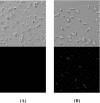Display of bacterial lipase on the Escherichia coli cell surface by using FadL as an anchoring motif and use of the enzyme in enantioselective biocatalysis
- PMID: 15345384
- PMCID: PMC520891
- DOI: 10.1128/AEM.70.9.5074-5080.2004
Display of bacterial lipase on the Escherichia coli cell surface by using FadL as an anchoring motif and use of the enzyme in enantioselective biocatalysis
Abstract
We have developed a novel cell surface display system by employing FadL as an anchoring motif, which is an outer membrane protein involved in long-chain fatty acid transport in Escherichia coli. A thermostable Bacillus sp. strain TG43 lipase (44.5 kDa) could be successfully displayed on the cell surface of E. coli in an active form by C-terminal deletion-fusion of lipase at the ninth external loop of FadL. The localization of the truncated FadL-lipase fusion protein on the cell surface was confirmed by confocal microscopy and Western blot analysis. Lipase activity was mainly detected with whole cells, but not with the culture supernatant, suggesting that cell lysis was not a problem. The activity of cell surface-displayed lipase was examined at different temperatures and pHs and was found to be the highest at 50 degrees C and pH 9 to 10. Cell surface-displayed lipase was quite stable, even at 60 and 70 degrees C, and retained over 90% of the full activity after incubation at 50 degrees C for a week. As a potential application, cell surface-displayed lipase was used as a whole-cell catalyst for kinetic resolution of racemic methyl mandelate. In 36 h of reaction, (S)-mandelic acid could be produced with the enantiomeric excess of 99% and the enantiomeric ratio of 292, which are remarkably higher than values obtained with crude lipase or cross-linked lipase crystal. These results suggest that FadL may be a useful anchoring motif for displaying enzymes on the cell surface of E. coli for whole-cell biocatalysis.
Figures







Similar articles
-
Display of lipase on the cell surface of Escherichia coli using OprF as an anchor and its application to enantioselective resolution in organic solvent.Biotechnol Bioeng. 2005 Apr 20;90(2):223-30. doi: 10.1002/bit.20399. Biotechnol Bioeng. 2005. PMID: 15739170
-
An efficient bacterial surface display system based on a novel outer membrane anchoring element from the Escherichia coli protein YiaT.FEMS Microbiol Lett. 2015 Jan;362(1):1-7. doi: 10.1093/femsle/fnu002. Epub 2014 Dec 4. FEMS Microbiol Lett. 2015. PMID: 25790485
-
Cell surface display of lipase in Pseudomonas putida KT2442 using OprF as an anchoring motif and its biocatalytic applications.Appl Environ Microbiol. 2005 Dec;71(12):8581-6. doi: 10.1128/AEM.71.12.8581-8586.2005. Appl Environ Microbiol. 2005. PMID: 16332850 Free PMC article.
-
Isolation of a potential anchoring motif based on proteome analysis of Escherichia coli and its use for cell surface display.Appl Biochem Biotechnol. 2013 Jun;170(4):787-804. doi: 10.1007/s12010-013-0236-9. Epub 2013 Apr 24. Appl Biochem Biotechnol. 2013. PMID: 23613117
-
Escherichia coli Surface Display: Advances and Applications in Biocatalysis.ACS Synth Biol. 2025 Mar 21;14(3):648-661. doi: 10.1021/acssynbio.4c00793. Epub 2025 Mar 6. ACS Synth Biol. 2025. PMID: 40047247 Review.
Cited by
-
Novel Bacterial Surface Display System Based on the Escherichia coli Protein MipA.J Microbiol Biotechnol. 2020 Jul 28;30(7):1097-1103. doi: 10.4014/jmb.2001.01053. J Microbiol Biotechnol. 2020. PMID: 32325544 Free PMC article.
-
Hydrophobic cell surface display system of PETase as a sustainable biocatalyst for PET degradation.Front Microbiol. 2022 Sep 29;13:1005480. doi: 10.3389/fmicb.2022.1005480. eCollection 2022. Front Microbiol. 2022. PMID: 36246227 Free PMC article.
-
Chromosomal insertions in the Lactobacillus casei upp gene that are useful for vaccine expression.Appl Environ Microbiol. 2014 Jun;80(11):3321-6. doi: 10.1128/AEM.00175-14. Epub 2014 Mar 21. Appl Environ Microbiol. 2014. PMID: 24657853 Free PMC article.
-
Display of multimeric antimicrobial peptides on the Escherichia coli cell surface and its application as whole-cell antibiotics.PLoS One. 2013;8(3):e58997. doi: 10.1371/journal.pone.0058997. Epub 2013 Mar 14. PLoS One. 2013. PMID: 23516591 Free PMC article.
-
Short-chain flavor ester synthesis in organic media by an E. coli whole-cell biocatalyst expressing a newly characterized heterologous lipase.PLoS One. 2014 Mar 26;9(3):e91872. doi: 10.1371/journal.pone.0091872. eCollection 2014. PLoS One. 2014. PMID: 24670408 Free PMC article.
References
-
- Ahmed, S. N., R. J. Kazlauskas, A. H. Morinville, P. Grochulski, J. D. Schrag, and M. W. Cygler. 1994. Enantioselectivity of Candida rugosa lipase toward carboxylic acids: a predictive rule from substrate mapping and X-ray crystallography. Biocatalysis 9:209-225.
-
- Bell, P. J. L., H. Nevalainen, H. W. Morgan, and P. L. Bergquist. 1999. Rapid cloning of thermoalkalophilic lipases from Bacillus spp. using PCR. Biotechnol. Lett. 21:1003-1006.
-
- Benhar, I. 2001. Biotechnological applications of phage and cell display. Biotechnol. Adv. 19:1-33. - PubMed
Publication types
MeSH terms
Substances
LinkOut - more resources
Full Text Sources
Other Literature Sources
Research Materials

